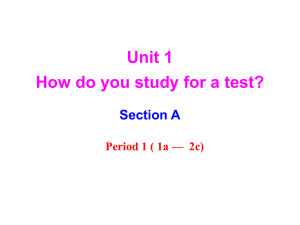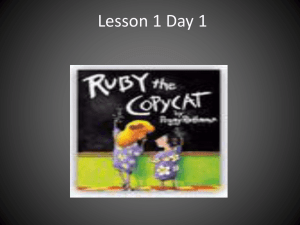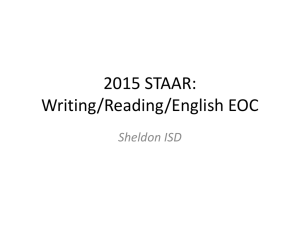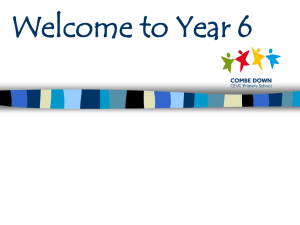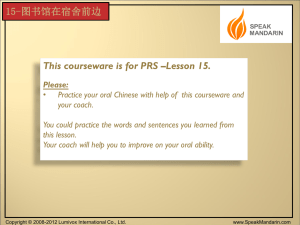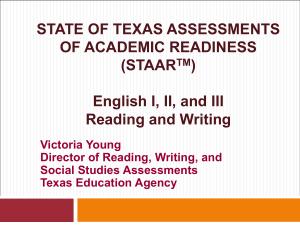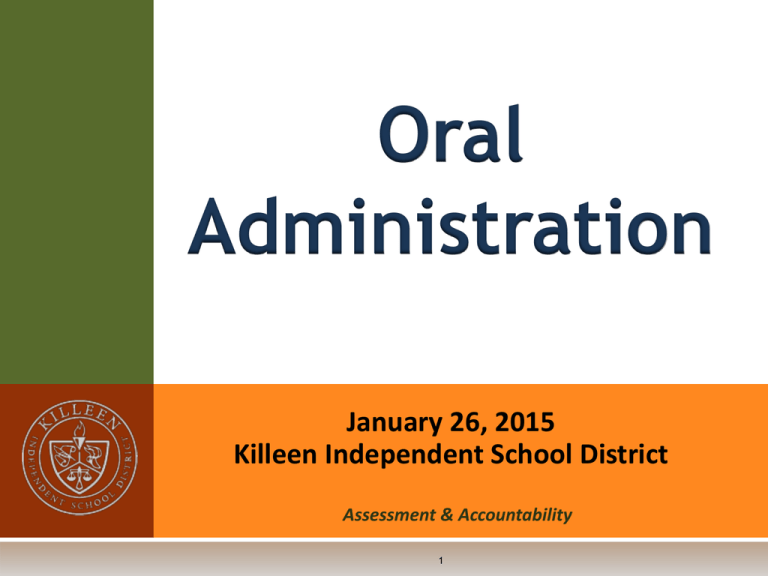
Oral
Administration
January 26, 2015
Killeen Independent School District
Assessment & Accountability
1
2
T RAINING FOR O RAL
A DMINISTRATIONS
Before conducting an oral administration, test administrators should read:
1. the instructions in appendix B of the appropriate Test Administrator
manual, and
2. the Oral/Signed Administration accommodation policy document found
on the Accommodations for Students with Disabilities webpage.
The campus coordinator will provide training in the procedures specific to an
oral administration as outlined in the appendix and the policy document.
If conducting a signed administration to students who are deaf or hard of
hearing, test administrators should also read the General Instructions for
Administering Statewide Assessments to Students Who are Deaf or Hard of
Hearing document, also found on the Accommodations for Students with
Disabilities webpage.
3
T RAINING FOR O RAL
A DMINISTRATIONS
For the purposes of this training, oral administration refers to the testing
accommodation in which a test administrator provides reading support
through speech and / or signing to a student who meets the eligibility
criteria.
In other words, this training does NOT address the functionality of the
speech-to-text tools in STAAR A, the standardized oral administration
(SOA) or STAAR L; however, it does address Pop-ups and Rollovers for
STAAR A because they can be read by a test administrator.
Additional information about these three assessments can be found
online at the webpages made by TEA especially for them.
STAAR A: http://tea.texas.gov/student.assessment/STAARA/
STAAR L: http://tea.texas.gov/student.assessment/ell/staarl/
SOA: http://tea.texas.gov/student.assessment/soa/
O RAL A DMINISTRATION P OLICIES
4
5
ORAL
ADMINISTRATION
Test questions and answer choices may be read aloud to eligible
students for the following tests:
mathematics
Please refer to the Oral/Signed Administration
science
accommodation policy found on the Accommodations
Resource webpage for oral administration eligibility.
social studies
reading
all EOC tests (except the English I-II writing section)
Two different levels of reading support:
read parts of the test questions and answer choices at
student request
read all test questions and answer choices throughout the
test
6
A SSESSMENTS IN D ETAIL
· STAAR and STAAR Spanish grades 3–8 reading
✓ Test questions, answer choices and required reference materials may be read
aloud to a student
✗ Reading selections may NOT be read aloud to a student
· STAAR grade 7 writing
✓ Required reference materials may be read aloud to a student
✗ Revising and editing passages, test questions, and answer choices may NOT be
read aloud to a student
· STAAR English I and English II
✓ Reading section: test questions, answer choices and required reference materials
may be read aloud to a student
✗ Reading section: reading selections may NOT be read aloud to a student
✓ Writing section: required reference materials may be read aloud to a student
✗ Writing section: revising and editing passages, test questions, and answer choices
may NOT be read aloud to a student
7
A SSESSMENTS IN D ETAIL
For a student who meets the eligibility criteria, this accommodation may be used
on ONLY
STAAR, STAAR Spanish and STAAR L Mathematics (grades 3–8, Algebra I)
✓ Test questions, answer choices and required reference materials may be
read aloud to a student
STAAR, STAAR Spanish and STAAR L Science (grades 5 and 8, Biology)
✓ Test questions, answer choices and required reference materials may be
read aloud to a student
STAAR and STAAR L Social Studies (grade 8, U.S. History)
✓ Test questions and answer choices may be read aloud to a student
8
A SSESSMENTS
IN
D ETAIL (C ONT.)
Oral administration is NOT allowed on:
• the Grade 4 writing test* and
• the writing (i.e. revising and editing) section of the English I
and English II tests.
The revising and editing passages, questions or answer choices on
these tests may NEVER be read aloud.
Special Circumstance: The reading selections on the following tests
may NEVER be read aloud to a student:
• the Grades 3-8 reading tests and
• the reading section of English I and English II tests.
* There are no required reference materials for grade 4 writing; however, allowable
accommodations (e.g., dictionary, supplemental aid) may be read aloud
9
ORAL
ADMINISTRATION
It is the responsibility of the ARD committee, Section 504 committee, or a
committee of knowledgeable persons to appropriately document the level of
reading support the student needs.
A student may request a change in the level of reading support provided during
testing ONLY if this option is documented. For example, the student may ask
that the test administrator only read words on an as-needed basis.
Test administrators must be made aware of 1) the level of reading support each
student is to receive AND 2) whether the student can change the level of
reading support during testing, based on the documentation in the student’s
paperwork.
10
T EST M ATERIALS FOR O RAL
A DMINISTRATIONS
Ensure That the Same Test Form Is Used
When giving an oral administration in which the test administrator reads ALL test
questions and answer choices throughout the test, the test administrator must
have a test booklet with the same form number as the students.
Form 1 is the overage in all STAAR shipments, so this will most likely be the
form that is used for oral administration groupings.
For STAAR Spanish (except for STAAR Spanish grade 5 science), spiraled sets
will be sent as overage in all shipments. For STAAR Spanish grade 5 science,
there is only one form. Therefore, the test administrator and the students
should automatically have the same form.
When giving an oral administration in which the test administrator reads parts of
test questions and/or answer choices at student request, it is acceptable to read
over the student’s shoulder. In these cases, the test administrator may or may
not have a separate test booklet.
O RAL A DMINISTRATION T RAINING
11
12
O RAL A DMINISTRATION T RAINING
Before conducting an oral administration, test
administrators should familiarize themselves with
Appendix B in the applicable Test Administration
Manual for the assessment they are administering and
with the information presented in the Oral/Signed
Administration accommodation policy found on the
Accommodation Resources webpage.
Campus test coordinators will provide additional
training in the procedures specific to an oral test
administration as outlined in these two documents.
13
O RAL A DMINISTRATION
Test Security
• All security measures outlined in the STAAR Test
Administrator Manuals must be followed.
• Test administrators must be aware that they are viewing
secure content and are therefore required to initial and
sign an additional section of the Oath of Test Security and
Confidentiality for Test Administrator.
• Test administrators may NOT respond to test questions,
make notes about test questions, or discuss the content of
the test at any time. In addition, test administrators may
not write notes or calculations in a test booklet.
• Nonverbal assistance may not be provided to students.
• After an oral administration, no discussion or scoring of
test items is allowed at any time.
14
O RAL A DMINISTRATION
Test Administration
• Oral administrations should be provided by test administrators
who are familiar with content-specific terms and symbols
associated with the subject-area test. This will ensure that the
test is administered accurately.
• Prior to beginning the test, test administrators should explain to
the student(s) the level of reading support they are allowed to
provide during the test based on the documentation in the
appropriate paperwork.
• Each word, phrase, and/or sentence in the test questions and
answer choices may be read aloud as many times as necessary.
At the end of the test, the test administrator may go back to
reread a question and its answer choices at a student’s request.
• No test content may be rephrased, clarified or interpreted.
15
O RAL A DMINISTRATION
Test Administration (continued)
• Voice inflection must be kept neutral during the reading aloud of
test questions and answer choices, although words that are
boldfaced, italicized, or printed entirely in capital letters must be
emphasized.
• Unauthorized verbal and nonverbal assistance may not be
provided to students.
• After an oral administration, no discussion or scoring of test items
is allowed at any time.
• For an oral administration of the test questions and answer
choices throughout the test, the test administrator and all
students must have test booklets with the same form number.
Students taking STAAR, STAAR L and STAAR Spanish assessments
CANNOT be tested together in these situations.
16
O RAL A DMINISTRATION
Test Administration (continued)
• Test administrators must understand when they may read aloud
all or only certain parts of a state assessment. Instructions for
reading aloud different types of test questions for every subject
can be found below.
• For READING tests, only the questions and answer choices may
be read aloud to an eligible student. The student must read the
selection first. When the student has finished reading the
selection, the test administrator may read aloud each test
question and then read the answer choices. The test questions
and answer choices must be read aloud in the order they are
presented. The reading selections may NEVER be read aloud to a
student.
17
O RAL A DMINISTRATION
Test Administration (continued)
• For mathematics, science, and social studies tests, any part of
the test may be read aloud to an eligible student. This applies to
words in the questions and the answer choices, including words
in graphics (e.g., table, graph, grid, diagram, map, photograph,
cartoon, or picture). The test administrator must read aloud the
test questions and answer choices in the order they are
presented. The test question must be read aloud prior to reading
the answer choices.
• For writing tests, an oral administration is NEVER allowed for any
part of the revising and editing passages, questions, or answer
choices. However, reading aloud the writing prompt is an
allowable test administration procedure for any student who
needs this assistance. More information about reading aloud the
writing prompt can be found in the District and Campus
Coordinator Manual.
18
O RAL A DMINISTRATION
Test Administration (continued)
• Required reference materials may be read aloud to an eligible
student. This includes the dictionary during reading and writing
tests, as well as the state-supplied mathematics and science
reference materials.
• Allowable accommodations may be read aloud to an eligible
student. This includes a dictionary or supplemental aid.
• For STAAR A:
• Pop-ups and rollovers are not read aloud. A test
administrator will need to read these aloud if a student
asks.
• A “do not read” icon has been placed on reading selections,
editing selections, and editing test questions to indicate
that these may NOT be read aloud by TTS or a test
administrator. Pop-ups and rollovers associated with these
pages may NOT be read aloud either.
O RAL A DMINISTRATION
GRADES 3-5
EXAMPLES
When the answer
choices contain
graphics (e.g.,
table, graph, grid,
diagram, map,
photograph,
cartoon, or
picture), do not
name or describe
them. Instead,
after reading the
test question, say
to the student,
“Look at the
answer choices
and mark your
answer.” If
necessary, say,
“Tell me whether
you would like
anything read
aloud.”
Grade 5 Science Example
Which diagram
shows what
would most
likely happen if
oil, water and a
cork were all
placed in one
container?
[“Look at the
answer choices
and mark your
answer. Tell me
whether you
would like
anything read
aloud.”] It is
NOT allowable
to point to the
parts of the
diagram that
represent oil,
water and cork.
Grades 3-5 Mathematics
Example
When a test question contains
a graphic (e.g., table, graph,
grid, diagram, map,
photograph, cartoon, or
picture), say to the student,
“Take a few moments to look at
the graphic and tell me whether
you would like anything read
aloud. Then let me know when
you are ready to go on.”
When reading aloud words,
numbers, or symbols, be
careful not to aid the student in
interpreting or analyzing the
information, since the ability to
interpret and analyze is part of
what is being tested. (Example:
it is NOT allowable to say, “This
[grocery store] is one of the
parking lots.”)
Grades 3-5 Reading
Example
When a test question
contains a text box
(e.g., formula, scale,
excerpt, quote from
the selection, or
caption), you may read
aloud the text. Do
NOT interpret or
analyze any of the
information.
You may read aloud
the boxed text in its
entirety.
When contentspecific terms
and symbols
appear in a test
question or
answer choices,
read them in the
same way the
student hears
them in daily
instruction. This
will ensure that
the test is
administered
accurately. (The
examples shown
are only
samples. Many
other contentspecific terms
and symbols
exist.
Grades 3-5 Mathematics
Example
Example: “A 15 lb” must be read
aloud as, “A, fifteen pounds.”
Grades 3-5 Mathematics Example
When the content
of a test question
requires
knowledge of
place value, read
the numbers as
individual digits
so as not to
provide assistance
in determining
the answer.
7
For example, read 3
100
as “three and seven over
one hundred.”
For example,
read “3.007” as
“three point zero
zero seven.”
O RAL A DMINISTRATION
GRADES 6-8
EXAMPLES
When the answer
choices contain
graphics (e.g.,
table, graph, grid,
diagram, map,
photograph,
cartoon, or
picture), do not
name or describe
them. Instead,
after reading the
test question, say
to the student,
“Look at the
answer choices
and mark your
answer.” If
necessary, say,
“Tell me whether
you would like
anything read
aloud.”
Grades 6-8 Mathematics Example
Which Venn
diagram best
represents this
information?
[“Look at the
answer choices
and mark your
answer. Tell me
whether you
would like
anything read
aloud.”] It is
NOT allowable
to say, “This
part of the
diagram shows
how many
eighth graders
are in band.”
Grade 8 Science Example
When a test question contains
a graphic (e.g., table, graph,
grid, diagram, map,
photograph, cartoon, or
picture), say to the student,
“Take a few moments to look at
the graphic and tell me whether
you would like anything read
aloud. Then let me know when
you are ready to go on.”
When reading aloud words,
numbers, or symbols, be
careful not to aid the student in
interpreting or analyzing the
information, since the ability to
interpret and analyze is part of
what is being tested. (Example:
it is NOT allowable to indicate
what the arrows underneath the
labels represent.)
Grade 8 Social
Studies Example
[“Take a few moments to
look at the map and tell me
whether you would like
anything read aloud. Then
let me know when you are
ready to go on.”]
Example: If a student needs
help reading this, point to
the words and say, “This
says over one million.” It is
NOT allowable to say, “The
largest dot means over one
million,” because that
would be interpreting the
key to the map.
Grades 6-8 Reading
and Math Examples
When a test question contains
a text box (e.g., formula, scale,
excerpt, quote from the
selection, or caption), you may
read aloud the text. Do NOT
interpret or analyze any of the
information.
You may read aloud the boxed
text in its entirety.
Examples: “C = 2𝜋𝑟” must be read as “C equals two, pi, r”
and “Circumference of a circle = 2 ∙ 𝜋 ∙ radius” must be read
as “Circumference of a circle equals two times pi times
radius.”
When contentspecific terms
and symbols
appear in a test
question or
answer choices,
read them in the
same way the
student hears
them in daily
instruction. This
will ensure that
the test is
administered
accurately. (The
examples shown
are only
samples. Many
other contentspecific terms
and symbols
exist.
Grade 8 Science and
Grades 6-8 Mathematics
Examples
Example: “𝐶3 𝐻8 + 5𝑂2 →”
must be read aloud as, “C
three H eight plus five O
two yields.”
32
Example: “A ” must
𝜋
be read aloud as, “A,
thirty-two over pi,” or “A,
thirty-two divided by pi.”
Example: “D 32 ∙ 2𝜋”
must be read aloud as,
“D, thirty-two times two
pi.”
O RAL A DMINISTRATION
EOC
EXAMPLES
When the answer
choices contain
graphics (e.g.,
table, graph, grid,
diagram, map,
photograph,
cartoon, or
picture), do not
name or describe
them. Instead,
after reading the
test question, say
to the student,
“Look at the
answer choices
and mark your
answer.” If
necessary, say,
“Tell me whether
you would like
anything read
aloud.”
Algebra I
Example
Which graph
models the
total fee for 3
books …?
[“Look at the
answer
choices and
mark your
answer. Tell
me whether
you would
like anything
read aloud.”
It is NOT
allowable to
name the
coordinates
of each point.]
Biology
When a test question contains
a graphic (e.g., table, graph,
grid, diagram, map,
photograph, cartoon, or
picture), say to the student,
“Take a few moments to look at
the graphic and tell me whether
you would like anything read
aloud. Then let me know when
you are ready to go on.”
When reading aloud words,
numbers, or symbols, be
careful not to aid the student in
interpreting or analyzing the
information, since the ability to
interpret and analyze is part of
what is being tested. (Example:
it is NOT allowable to indicate
that Phytoplankton is a
producer.)
U.S. History
Example
[“Take a few moments to
look at the graphic and tell
me if you would like
anything read aloud. Then
let me know when you are
ready to go on.”]
Example: If this is read
aloud, do not define any
terms. You may only read
aloud the words shown.
English I
Example
When a test question
contains a text box
(e.g., formula, scale,
excerpt, quote from
the selection, or
caption), you may read
aloud the text. Do
NOT interpret or
analyze any of the
information.
You may read aloud
the boxed text in its
entirety.
U.S. History
Example
You may read aloud
the boxed text in its
entirety.
When contentspecific terms
and symbols
appear in a test
question or
answer choices,
read them in the
same way the
student hears
them in daily
instruction. This
will ensure that
the test is
administered
accurately. (The
examples shown
are only
samples. Many
other contentspecific terms
and symbols
exist.
Example: 𝑦 = 2𝑥 must be read
aloud as, “y is equal to 2 to the x
power.”
Example: 𝑦 = 𝑥
must be read aloud as, “y
is equal to the square root
of x.”
Algebra I
Example
Biology
Example
Example: (B) must
be read aloud as,
“capital B,”
“uppercase B,” or
“big B.”
Example: 2 BB: 1 Bb: 0 bb
must be read aloud as, “two
capital B capital B, one capital
B lowercase B, zero lowercase
B lowercase B.”

